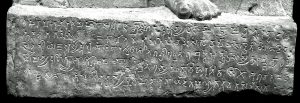
Spurious inscription of Kumāragupta dated 100 10 2
Published in D. M. Stadtner, Orientations, 33 (2002): 26-30 and Harry Falk, “The Kaniṣka Era in Gupta Records,” Silk Road Art & Archaeology 10 (2004): 167-176, but a forgery drawing on a variety of motifs and forms in known sculptures of the period, see Claudine Bautze-Pircon, “The Rewriting of Indian Art History,” Orientations 33 (2002): 69-70 wherein Gouriswar Bhattacharya’s assessment of the inscription as modern is also cited. The dated portion reads: kumāraguptasy vijayarājyasaṃvvatsare dvādaśotta[ra]śatatame saṃ [100* completely effaced] [10 partly visible] 2 kālānuvartamāne paṃcame saṃ 5 varṣāmāse dvitīye 2 divase tritīya 3. The forger effaced the number 100 to address the problem that there is no example of 100 from the Gupta period appearing in Falk’s Indoskript: http://www.indologie.uni-halle.de/forschung/indoskript/ The Indoskript programme was funded by the DFG 2000-2005 indicating the forger had access to an early version of the dataset. This is now available online at: http://www.indoskript.org/